Deck 13: Genetic Counseling
Question
Question
Question
Question
Question
Question
Question
Question
Question
Question
Question
Question
Question
Question
Question
Question
Question
Question
Question
Question
Question
Question
Question
Question
Question
Question
Question
Question
Question
Question
Question
Question
Question
Question
Question
Question
Question
Question
Question
Question
Question
Question
Question
Question
Question
Question
Question
Question
Question
Question

Unlock Deck
Sign up to unlock the cards in this deck!
Unlock Deck
Unlock Deck
1/50
Play
Full screen (f)
Deck 13: Genetic Counseling
1
A pedigree chart is an important tool for a genetic counselor because
A) it provides the genotype of all the family members.
B) it shows the family history for one genetic trait.
C) it shows whether a child will have a genetic disorder or not.
D) it does not reveal the sexes of the individuals.
E) it reveals the mode of inheritance of any particular genetic trait.
A) it provides the genotype of all the family members.
B) it shows the family history for one genetic trait.
C) it shows whether a child will have a genetic disorder or not.
D) it does not reveal the sexes of the individuals.
E) it reveals the mode of inheritance of any particular genetic trait.
B
Explanation: It is not always possible to determine an individual's genotype from a pedigree. Likewise, it is not always possible to determine the mode of inheritance of a trait from a pedigree. Pedigrees do, however, document family histories of genetic traits, and the exhaustive analysis of pedigrees for the same genetic trait often yield useful information regarding the trait's mode of inheritance.
Explanation: It is not always possible to determine an individual's genotype from a pedigree. Likewise, it is not always possible to determine the mode of inheritance of a trait from a pedigree. Pedigrees do, however, document family histories of genetic traits, and the exhaustive analysis of pedigrees for the same genetic trait often yield useful information regarding the trait's mode of inheritance.
2
Figure: 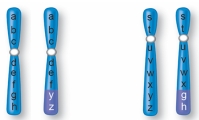
You are a genetic counselor, and a man with the translocation shown in the figure is your client. He and his partner (who has a normal karyotype) wish to have children. You explain to him that the probability of having a child with the same translocation as the father is _______.
A) 0%
B) 25%
C) 50%
D) 75%
E) 100%

You are a genetic counselor, and a man with the translocation shown in the figure is your client. He and his partner (who has a normal karyotype) wish to have children. You explain to him that the probability of having a child with the same translocation as the father is _______.
A) 0%
B) 25%
C) 50%
D) 75%
E) 100%
B
Explanation: By the law of segregation, either chromosome of the first pair may be passed into a gamete with either chromosome of the second pair. Thus, if all four possible gametes that could result are drawn out, there is one possible gamete of the four that would contain both abnormal chromosomes, and thus the same balanced translocation as the father.
Explanation: By the law of segregation, either chromosome of the first pair may be passed into a gamete with either chromosome of the second pair. Thus, if all four possible gametes that could result are drawn out, there is one possible gamete of the four that would contain both abnormal chromosomes, and thus the same balanced translocation as the father.
3
Which mode or modes of inheritance are possible for the pedigree shown here? 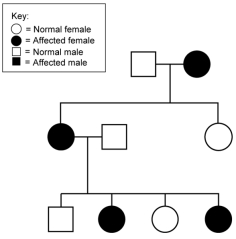
A) autosomal dominant, autosomal recessive, or X-linked dominant
B) autosomal recessive or X-linked recessive
C) X-linked recessive
D) autosomal dominant, autosomal recessive, or X-linked recessive
E) autosomal dominant or X-linked dominant

A) autosomal dominant, autosomal recessive, or X-linked dominant
B) autosomal recessive or X-linked recessive
C) X-linked recessive
D) autosomal dominant, autosomal recessive, or X-linked recessive
E) autosomal dominant or X-linked dominant
A
Explanation: The only mode of inheritance that can be ruled out is X-linked recessive, because there would be an affected daughter with an unaffected father. This is not possible for that mode of inheritance. All others are possible.Learning Outcome: 13.02.01 Interpret a pedigree to determine if the pattern of inheritance is autosomal dominant or recessive.
Explanation: The only mode of inheritance that can be ruled out is X-linked recessive, because there would be an affected daughter with an unaffected father. This is not possible for that mode of inheritance. All others are possible.Learning Outcome: 13.02.01 Interpret a pedigree to determine if the pattern of inheritance is autosomal dominant or recessive.
4
Which of the following syndromes is caused by a translocation?
A) Alagille syndrome
B) invdup 15 syndrome
C) Williams syndrome
D) Cri-du-chat syndrome
E) Turner syndrome
A) Alagille syndrome
B) invdup 15 syndrome
C) Williams syndrome
D) Cri-du-chat syndrome
E) Turner syndrome

Unlock Deck
Unlock for access to all 50 flashcards in this deck.
Unlock Deck
k this deck
5
A parent has a deletion on one homologue of a pair of chromosomes. What is the probability of this individual's child carrying the same deletion?
A) 0%
B) 25%
C) 50%
D) 75%
E) 100%
A) 0%
B) 25%
C) 50%
D) 75%
E) 100%

Unlock Deck
Unlock for access to all 50 flashcards in this deck.
Unlock Deck
k this deck
6
What is/are the possible genotypes of the individual marked with a * on this pedigree if the mode of inheritance is autosomal recessive? 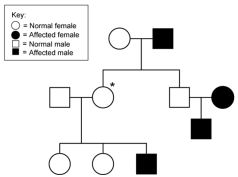
A) AA
B) AA or Aa
C) aa
D) cannot be determined
E) Aa

A) AA
B) AA or Aa
C) aa
D) cannot be determined
E) Aa

Unlock Deck
Unlock for access to all 50 flashcards in this deck.
Unlock Deck
k this deck
7
Chromosome 7 may lose an end piece resulting in Williams syndrome. This is an example of a(n)
A) inversion.
B) duplication.
C) deletion.
D) translocation.
E) epigenetic inheritance.
A) inversion.
B) duplication.
C) deletion.
D) translocation.
E) epigenetic inheritance.

Unlock Deck
Unlock for access to all 50 flashcards in this deck.
Unlock Deck
k this deck
8
A missing piece of chromosome 5 may result in a child whose glottis and larynx do not develop properly resulting in an abnormal cry. This is called ________.
A) Cri du chat syndrome
B) Huntington syndrome
C) Klinefelter syndrome
D) inv dup 15 syndrome
E) Down syndrome
A) Cri du chat syndrome
B) Huntington syndrome
C) Klinefelter syndrome
D) inv dup 15 syndrome
E) Down syndrome

Unlock Deck
Unlock for access to all 50 flashcards in this deck.
Unlock Deck
k this deck
9
Inversions are chromosomal mutations that
A) always result in a syndrome.
B) neither increase nor decrease the amount of genetic material in the cell.
C) rarely cause deletions or duplications during gamete formation when crossing-over occurs.
D) result from duplication of a portion of a chromosome.
E) never disrupt gene regulation or cause physical abnormalities.
A) always result in a syndrome.
B) neither increase nor decrease the amount of genetic material in the cell.
C) rarely cause deletions or duplications during gamete formation when crossing-over occurs.
D) result from duplication of a portion of a chromosome.
E) never disrupt gene regulation or cause physical abnormalities.

Unlock Deck
Unlock for access to all 50 flashcards in this deck.
Unlock Deck
k this deck
10
A karyotype shows chromosomes arranged by
A) banding patterns, size, and shape.
B) shape, size, and complexity.
C) complexity, radius, and length.
D) length, structure, and color.
E) color, width, and length.
A) banding patterns, size, and shape.
B) shape, size, and complexity.
C) complexity, radius, and length.
D) length, structure, and color.
E) color, width, and length.

Unlock Deck
Unlock for access to all 50 flashcards in this deck.
Unlock Deck
k this deck
11
If the mode of inheritance for the pedigree shown here is X-linked dominant, what is/are the possible phenotype(s) of the individual marked with a *? 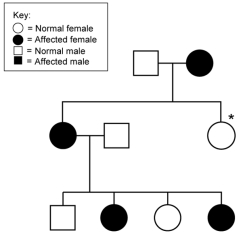
A) XBXB
B) XBXb
C) XbXb
D) XBXB or XBXb
E) cannot be determined

A) XBXB
B) XBXb
C) XbXb
D) XBXB or XBXb
E) cannot be determined

Unlock Deck
Unlock for access to all 50 flashcards in this deck.
Unlock Deck
k this deck
12
Figure: 
You are a genetic counselor, and a man with the translocation shown in the figure is your client. He and his partner (who has a normal karyotype) wish to have children. You explain to him that the probability of having a child with an unbalanced translocation is ______.
A) 0%
B) 25%
C) 50%
D) 75%
E) 100%

You are a genetic counselor, and a man with the translocation shown in the figure is your client. He and his partner (who has a normal karyotype) wish to have children. You explain to him that the probability of having a child with an unbalanced translocation is ______.
A) 0%
B) 25%
C) 50%
D) 75%
E) 100%

Unlock Deck
Unlock for access to all 50 flashcards in this deck.
Unlock Deck
k this deck
13
Amniocentesis may be preferred over chorionic villus sampling (CVS) for karyotyping because
A) CVS is a less invasive procedure and has a faster recovery time.
B) amniocentesis can be performed more quickly than CVS.
C) CVS carries a lower risk of miscarriage than amniocentesis.
D) a larger amount of tissue may be taken, allowing the results to be obtained more quickly.
E) amniocentesis may be performed at an earlier stage of pregnancy and so the risk of miscarriage is higher.
A) CVS is a less invasive procedure and has a faster recovery time.
B) amniocentesis can be performed more quickly than CVS.
C) CVS carries a lower risk of miscarriage than amniocentesis.
D) a larger amount of tissue may be taken, allowing the results to be obtained more quickly.
E) amniocentesis may be performed at an earlier stage of pregnancy and so the risk of miscarriage is higher.

Unlock Deck
Unlock for access to all 50 flashcards in this deck.
Unlock Deck
k this deck
14
If the mode of inheritance for the pedigree shown here is X-linked dominant, what is/are the possible phenotype(s) of the individual marked with a *? 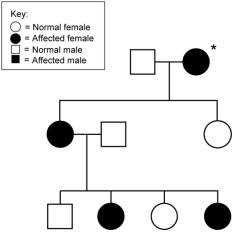
A) XBXB
B) XBXb
C) XbXb
D) XBXB or XBXb
E) cannot be determined

A) XBXB
B) XBXb
C) XbXb
D) XBXB or XBXb
E) cannot be determined

Unlock Deck
Unlock for access to all 50 flashcards in this deck.
Unlock Deck
k this deck
15
A man carrying a translocation may appear normal, but runs the risk of having children with a syndrome because his children
A) may inherit both abnormal chromosomes from the father and would thus carry a deletion.
B) may inherit one abnormal chromosome with one normal one from the father, and would carry a deletion or duplication.
C) will inherit one abnormal chromosome from both the mother and father.
D) may inherit both normal chromosomes from the father and an abnormal one from the mother.
E) carry the same translocation as the father.
A) may inherit both abnormal chromosomes from the father and would thus carry a deletion.
B) may inherit one abnormal chromosome with one normal one from the father, and would carry a deletion or duplication.
C) will inherit one abnormal chromosome from both the mother and father.
D) may inherit both normal chromosomes from the father and an abnormal one from the mother.
E) carry the same translocation as the father.

Unlock Deck
Unlock for access to all 50 flashcards in this deck.
Unlock Deck
k this deck
16
Chromosomes for karyotyping are often obtained from a blood sample. Red blood cells, however, cannot be used for this purpose because
A) they are too small.
B) they lack nuclei.
C) white blood cells are much more common.
D) they have abnormal chromosomes.
E) they are difficult to isolate.
A) they are too small.
B) they lack nuclei.
C) white blood cells are much more common.
D) they have abnormal chromosomes.
E) they are difficult to isolate.

Unlock Deck
Unlock for access to all 50 flashcards in this deck.
Unlock Deck
k this deck
17
Figure: 
You are a genetic counselor, and a man with the translocation shown in the figure is your client. He and his partner (who has a normal karyotype) wish to have children. You explain to him that the probability of having a child with a normal karyotype is _______.
A) 0%
B) 25%
C) 50%
D) 75%
E) 100%

You are a genetic counselor, and a man with the translocation shown in the figure is your client. He and his partner (who has a normal karyotype) wish to have children. You explain to him that the probability of having a child with a normal karyotype is _______.
A) 0%
B) 25%
C) 50%
D) 75%
E) 100%

Unlock Deck
Unlock for access to all 50 flashcards in this deck.
Unlock Deck
k this deck
18
When a chromosome carrying an inversion undergoes crossing-over,
A) all four chromatids of the tetrad will contain a duplication or deletion.
B) two chromatids will carry both a duplication and a deletion, one will contain the inversion, and one will be normal.
C) two chromatids will carry both a duplication and a deletion, and the other two will contain the inversion.
D) all four chromatids will be normal.
E) two chromatids will carry the inversion, and the other two will be normal.
A) all four chromatids of the tetrad will contain a duplication or deletion.
B) two chromatids will carry both a duplication and a deletion, one will contain the inversion, and one will be normal.
C) two chromatids will carry both a duplication and a deletion, and the other two will contain the inversion.
D) all four chromatids will be normal.
E) two chromatids will carry the inversion, and the other two will be normal.

Unlock Deck
Unlock for access to all 50 flashcards in this deck.
Unlock Deck
k this deck
19
Amniocentesis may be preferred over chorionic villus sampling (CVS) for karyotyping because
A) CVS takes much longer to obtain a karyotype.
B) CVS is a more invasive procedure.
C) amniocentesis has a lower risk of miscarriage than CVS.
D) amniocentesis can be performed more quickly than CVS.
E) a larger amount of tissue may be obtained through amniocentesis.
A) CVS takes much longer to obtain a karyotype.
B) CVS is a more invasive procedure.
C) amniocentesis has a lower risk of miscarriage than CVS.
D) amniocentesis can be performed more quickly than CVS.
E) a larger amount of tissue may be obtained through amniocentesis.

Unlock Deck
Unlock for access to all 50 flashcards in this deck.
Unlock Deck
k this deck
20
What is a possible inheritance pattern for the pedigree shown here? 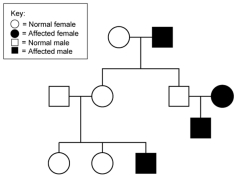
A) autosomal dominant
B) autosomal recessive
C) X-linked recessive
D) could be autosomal recessive or X-linked recessive
E) X-linked dominant

A) autosomal dominant
B) autosomal recessive
C) X-linked recessive
D) could be autosomal recessive or X-linked recessive
E) X-linked dominant

Unlock Deck
Unlock for access to all 50 flashcards in this deck.
Unlock Deck
k this deck
21
A genetic profile includes
A) the location of all known genes in the human genome.
B) the entire base sequence of an individual's genome.
C) all of an individual's normal genes.
D) an individual's complete genotype, including mutations.
E) all of an individual's genetic markers.
A) the location of all known genes in the human genome.
B) the entire base sequence of an individual's genome.
C) all of an individual's normal genes.
D) an individual's complete genotype, including mutations.
E) all of an individual's genetic markers.

Unlock Deck
Unlock for access to all 50 flashcards in this deck.
Unlock Deck
k this deck
22
What kinds of mutations can be revealed through ultrasound?
A) Some chromosomal abnormalities, such as Down syndrome and Edwards syndrome, and a few other known inherited disorders.
B) The genetic profile, including any mutant gene alleles the fetus may have.
C) All chromosomal mutations, including deletions, duplications, inversions, and translocations.
D) Only larger chromosomal mutations, such as the large deletion seen in individuals with cri du chat syndrome.
E) Only inherited genetic disorders caused by single gene mutations.
A) Some chromosomal abnormalities, such as Down syndrome and Edwards syndrome, and a few other known inherited disorders.
B) The genetic profile, including any mutant gene alleles the fetus may have.
C) All chromosomal mutations, including deletions, duplications, inversions, and translocations.
D) Only larger chromosomal mutations, such as the large deletion seen in individuals with cri du chat syndrome.
E) Only inherited genetic disorders caused by single gene mutations.

Unlock Deck
Unlock for access to all 50 flashcards in this deck.
Unlock Deck
k this deck
23
Which of the following diseases are caused by an autosomal dominant allele?
A) cystic fibrosis and Marfan syndrome
B) Marfan syndrome and Huntington disease
C) Huntington disease and Duchenne muscular dystrophy
D) alkaptonuria and Huntington disease
E) sickle cell disease and Marfan syndrome
A) cystic fibrosis and Marfan syndrome
B) Marfan syndrome and Huntington disease
C) Huntington disease and Duchenne muscular dystrophy
D) alkaptonuria and Huntington disease
E) sickle cell disease and Marfan syndrome

Unlock Deck
Unlock for access to all 50 flashcards in this deck.
Unlock Deck
k this deck
24
What are the current known methods of delivering genes to cells for gene therapy?
A) viruses, liposomes, and nasal sprays
B) viruses, nasal sprays, and gene guns
C) liposomes, nasal sprays, and chemical transformation
D) nasal sprays, liposomes, and gene guns
E) viruses and gene guns
A) viruses, liposomes, and nasal sprays
B) viruses, nasal sprays, and gene guns
C) liposomes, nasal sprays, and chemical transformation
D) nasal sprays, liposomes, and gene guns
E) viruses and gene guns

Unlock Deck
Unlock for access to all 50 flashcards in this deck.
Unlock Deck
k this deck
25
Defective chloride ion channels in the plasma membrane cause thick mucus of tissues lining the airways and parts of the digestive system. This is an inherited disorder called ________.
A) alkaptonuria
B) cystic fibrosis
C) sickle cell disease
D) Tay-Sachs disease
E) Huntington disease
A) alkaptonuria
B) cystic fibrosis
C) sickle cell disease
D) Tay-Sachs disease
E) Huntington disease

Unlock Deck
Unlock for access to all 50 flashcards in this deck.
Unlock Deck
k this deck
26
A man with an X-linked recessive trait has a daughter with a woman who does not exhibit the trait. What is/are the possible genotype(s) of the daughter?
A) XbXb
B) XBXB
C) XBXb or XbXb
D) XBXb
E) XBXB or XBXb
A) XbXb
B) XBXB
C) XBXb or XbXb
D) XBXb
E) XBXB or XBXb

Unlock Deck
Unlock for access to all 50 flashcards in this deck.
Unlock Deck
k this deck
27
A man and a woman both unaffected by an autosomal dominant trait have a child. What is the probability that the child will inherit the disorder?
A) 0%
B) 25%
C) 50%
D) 75%
E) 100%
A) 0%
B) 25%
C) 50%
D) 75%
E) 100%

Unlock Deck
Unlock for access to all 50 flashcards in this deck.
Unlock Deck
k this deck
28
A known abnormality in a gene's sequence that can be linked to a genetic disease is called a(n)
A) genetic profile.
B) enzyme.
C) genetic marker.
D) DNA microarray.
E) genomic DNA.
A) genetic profile.
B) enzyme.
C) genetic marker.
D) DNA microarray.
E) genomic DNA.

Unlock Deck
Unlock for access to all 50 flashcards in this deck.
Unlock Deck
k this deck
29
A child with bluish-purple skin is found to lack the enzyme diaphorase and is subsequently diagnosed with which genetic disorder?
A) methemoglobinemia
B) Duchenne muscular dystrophy
C) Marfan syndrome
D) sickle cell disease
E) color blindness
A) methemoglobinemia
B) Duchenne muscular dystrophy
C) Marfan syndrome
D) sickle cell disease
E) color blindness

Unlock Deck
Unlock for access to all 50 flashcards in this deck.
Unlock Deck
k this deck
30
An embryo produced by in vitro fertilization (IVF) may be tested for genetic disorders prior to implantation. How is this accomplished?
A) Fetal cells are recovered from the mother's blood, and the DNA analyzed with a DNA microarray.
B) Amniocentesis or chorionic villus sampling is performed, and a karyotype assembled.
C) A polar body is isolated and its DNA amplified by PCR for analysis by DNA microarray.
D) A single cell is removed from a 6 to 8-celled embryo, and its DNA analyzed with a DNA microarray.
E) Blood is drawn from the embryo for genetic marker analysis.
A) Fetal cells are recovered from the mother's blood, and the DNA analyzed with a DNA microarray.
B) Amniocentesis or chorionic villus sampling is performed, and a karyotype assembled.
C) A polar body is isolated and its DNA amplified by PCR for analysis by DNA microarray.
D) A single cell is removed from a 6 to 8-celled embryo, and its DNA analyzed with a DNA microarray.
E) Blood is drawn from the embryo for genetic marker analysis.

Unlock Deck
Unlock for access to all 50 flashcards in this deck.
Unlock Deck
k this deck
31
Sickle cell disease and cystic fibrosis both exhibit what mode of inheritance?
A) X-linked recessive
B) autosomal dominant
C) Y-linked recessive
D) autosomal recessive
E) X-linked dominant
A) X-linked recessive
B) autosomal dominant
C) Y-linked recessive
D) autosomal recessive
E) X-linked dominant

Unlock Deck
Unlock for access to all 50 flashcards in this deck.
Unlock Deck
k this deck
32
A DNA microarray detects
A) mutant gene alleles associated with disease.
B) an individual's complete genotype, including all the various mutations.
C) chromosomal abnormalities, such as duplications or deletions.
D) fetal cells in the mother's blood.
E) viral DNA in an individual's cells.
A) mutant gene alleles associated with disease.
B) an individual's complete genotype, including all the various mutations.
C) chromosomal abnormalities, such as duplications or deletions.
D) fetal cells in the mother's blood.
E) viral DNA in an individual's cells.

Unlock Deck
Unlock for access to all 50 flashcards in this deck.
Unlock Deck
k this deck
33
A man has an X-linked dominant genetic disorder. If he has a daughter with an unaffected woman, what is the probability that the daughter will inherit the disorder?
A) 0%
B) 25%
C) 50%
D) 75%
E) 100%
A) 0%
B) 25%
C) 50%
D) 75%
E) 100%

Unlock Deck
Unlock for access to all 50 flashcards in this deck.
Unlock Deck
k this deck
34
A person with familial hypercholesterolemia is participating in an ex-vivo gene therapy trial. The procedure involves
A) infecting a portion of the person's liver with a retrovirus containing a normal gene for a cholesterol receptor.
B) spraying the normal gene for the cholesterol receptor into the nose.
C) insertion of the cholesterol receptor gene into a virus, then injecting the virus into the person.
D) removing a piece of the person's liver, infecting it with a retrovirus containing the normal cholesterol receptor gene, and replacing it after treatment.
E) transplanting a normal liver into the individual.
A) infecting a portion of the person's liver with a retrovirus containing a normal gene for a cholesterol receptor.
B) spraying the normal gene for the cholesterol receptor into the nose.
C) insertion of the cholesterol receptor gene into a virus, then injecting the virus into the person.
D) removing a piece of the person's liver, infecting it with a retrovirus containing the normal cholesterol receptor gene, and replacing it after treatment.
E) transplanting a normal liver into the individual.

Unlock Deck
Unlock for access to all 50 flashcards in this deck.
Unlock Deck
k this deck
35
Ex vivo gene therapy differs from in vivo gene therapy in that
A) ex vivo gene therapy involves directly introducing the gene into the body.
B) in vivo gene therapy involves directly introducing the gene into the body.
C) in vivo gene therapy only employs viruses for gene transfer.
D) ex vivo gene therapy only employs viruses for gene transfer.
E) ex vivo gene therapy can employ viruses, nasal sprays, or liposomes for gene transfer, but only liposomes may be used for in vivo gene therapy.
A) ex vivo gene therapy involves directly introducing the gene into the body.
B) in vivo gene therapy involves directly introducing the gene into the body.
C) in vivo gene therapy only employs viruses for gene transfer.
D) ex vivo gene therapy only employs viruses for gene transfer.
E) ex vivo gene therapy can employ viruses, nasal sprays, or liposomes for gene transfer, but only liposomes may be used for in vivo gene therapy.

Unlock Deck
Unlock for access to all 50 flashcards in this deck.
Unlock Deck
k this deck
36
Which one of the following diseases or disorders has not been treated using gene therapy methods?
A) rheumatoid arthritis
B) familial hypercholesterolemia
C) cri du chat syndrome
D) sickle cell disease
E) Duchenne muscular dystrophy
A) rheumatoid arthritis
B) familial hypercholesterolemia
C) cri du chat syndrome
D) sickle cell disease
E) Duchenne muscular dystrophy

Unlock Deck
Unlock for access to all 50 flashcards in this deck.
Unlock Deck
k this deck
37
A defective protein called fibrillin can cause an individual to possess abnormal connective tissue. This is an inherited disorder called
A) Marfan syndrome.
B) Duchenne muscular dystrophy.
C) alkaptonuria.
D) methemoglobinemia.
E) sickle cell disease.
A) Marfan syndrome.
B) Duchenne muscular dystrophy.
C) alkaptonuria.
D) methemoglobinemia.
E) sickle cell disease.

Unlock Deck
Unlock for access to all 50 flashcards in this deck.
Unlock Deck
k this deck
38
A woman has an X-linked recessive trait. What must her mother's genotype be?
A) XbXb
B) XBXB
C) XBXb or XbXb
D) XBXB or XbXb
E) XBXB or XBXb
A) XbXb
B) XBXB
C) XBXb or XbXb
D) XBXB or XbXb
E) XBXB or XBXb

Unlock Deck
Unlock for access to all 50 flashcards in this deck.
Unlock Deck
k this deck
39
If a man has an X-linked recessive disorder, then his daughters
A) will all have the disorder.
B) cannot be a carrier for the disorder.
C) cannot inherit the disease-causing allele.
D) will not have the disorder.
E) will be carriers for the disorder.
A) will all have the disorder.
B) cannot be a carrier for the disorder.
C) cannot inherit the disease-causing allele.
D) will not have the disorder.
E) will be carriers for the disorder.

Unlock Deck
Unlock for access to all 50 flashcards in this deck.
Unlock Deck
k this deck
40
Down syndrome could not be treated by gene therapy because
A) scientists do not know which faulty genes cause the syndrome.
B) Down syndrome is caused by possessing extra copies of genes of an entire chromosome, and adding more genes would not help.
C) liposomes and nasal sprays cannot be used due to abnormalities in the respiratory tract of Down syndrome individuals.
D) there are too many genes involved in the syndrome.
E) the gene therapy treatment could not be performed on an adult individual.
A) scientists do not know which faulty genes cause the syndrome.
B) Down syndrome is caused by possessing extra copies of genes of an entire chromosome, and adding more genes would not help.
C) liposomes and nasal sprays cannot be used due to abnormalities in the respiratory tract of Down syndrome individuals.
D) there are too many genes involved in the syndrome.
E) the gene therapy treatment could not be performed on an adult individual.

Unlock Deck
Unlock for access to all 50 flashcards in this deck.
Unlock Deck
k this deck
41
Testing for a protein may help reveal whether or not an individual has a genetic disorder.

Unlock Deck
Unlock for access to all 50 flashcards in this deck.
Unlock Deck
k this deck
42
A translocation chromosomal mutation is the exchange of segments between two homologous chromosomes.

Unlock Deck
Unlock for access to all 50 flashcards in this deck.
Unlock Deck
k this deck
43
A mutation in a gene that causes the protein to acquire an abnormal activity, such as aggregating within the cell, will usually cause a dominant inherited disorder.

Unlock Deck
Unlock for access to all 50 flashcards in this deck.
Unlock Deck
k this deck
44
Mutant gene alleles associated with known genetic disorders can be detected using DNA microarray analysis.

Unlock Deck
Unlock for access to all 50 flashcards in this deck.
Unlock Deck
k this deck
45
A child can show a genetic disorder even if neither parent has the disorder.

Unlock Deck
Unlock for access to all 50 flashcards in this deck.
Unlock Deck
k this deck
46
Chorionic villus sampling carries less risk of causing miscarriage than amniocentesis.

Unlock Deck
Unlock for access to all 50 flashcards in this deck.
Unlock Deck
k this deck
47
All sons of a man with a Y-linked disorder will also show the disorder.

Unlock Deck
Unlock for access to all 50 flashcards in this deck.
Unlock Deck
k this deck
48
In pedigrees of autosomal dominant traits, every affected child must have at least one affected parent.

Unlock Deck
Unlock for access to all 50 flashcards in this deck.
Unlock Deck
k this deck
49
A female child with an unaffected father can exhibit an X-linked recessive disorder.

Unlock Deck
Unlock for access to all 50 flashcards in this deck.
Unlock Deck
k this deck
50
To perform an in vivo gene therapy treatment, cells are removed from the patient's body, normal genes are added to them, and then the cells are returned to the patient's body.

Unlock Deck
Unlock for access to all 50 flashcards in this deck.
Unlock Deck
k this deck



